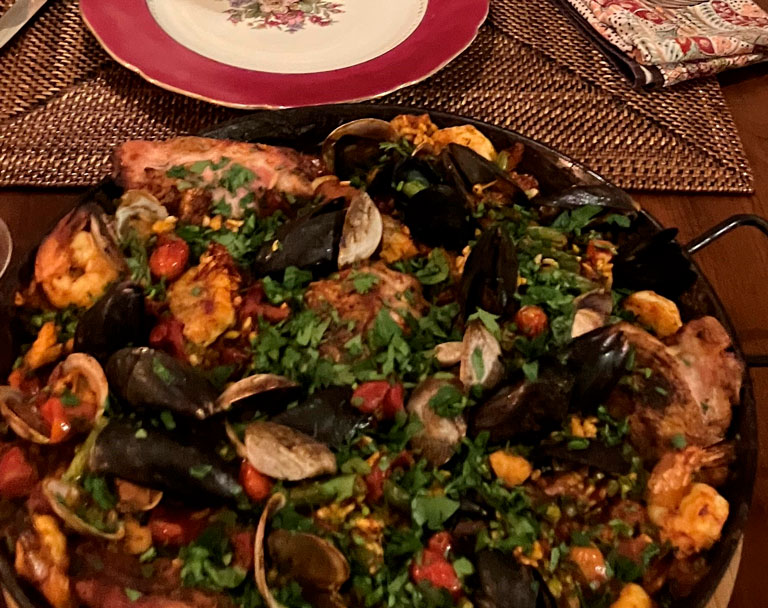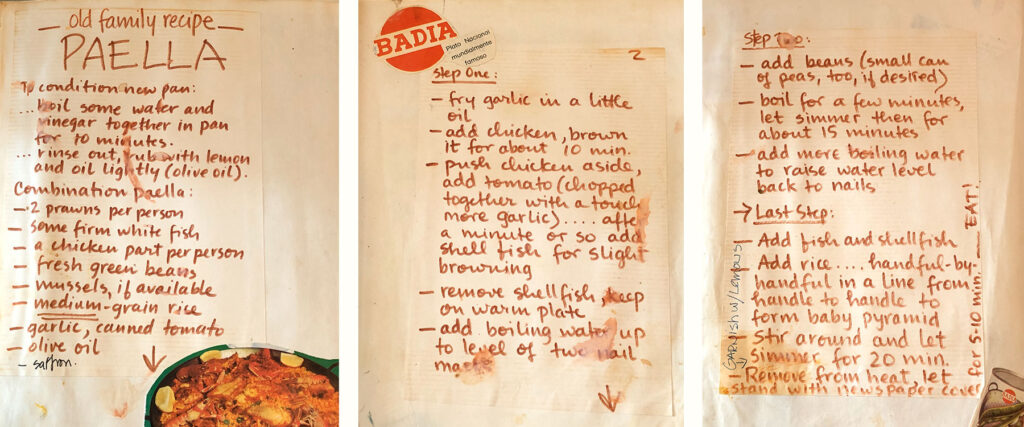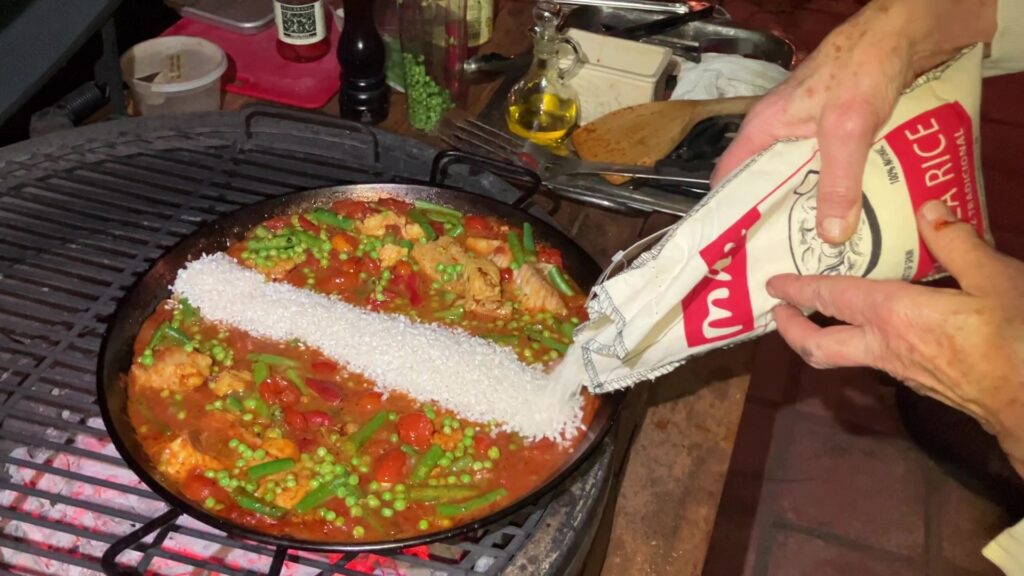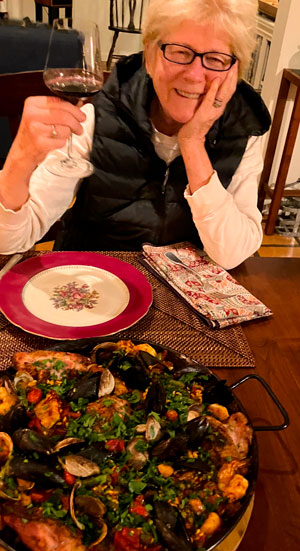
“One of the many things that we love about wine is that each bottle, each glass, each taste can take us on an adventure. It could be a dream, a memory, a voyage, perhaps to the home of that wine, where it was born. And the wine wants food, the food of its home—here can be found the classic pairings. Tempranillo takes us to Spain and one of its many classic dishes, Paella.” —Chris Howell
One of the many things that we love about wine is that each bottle, each glass, each taste can take us on an adventure. It could be a dream, a memory, a voyage, perhaps to the home of that wine, where it was born. And the wine wants food, the food of its home—here can be found the classic pairings. Tempranillo takes us to Spain and one of its many classic dishes, Paella.
To my palate, our 2022 Cain OTO Tempranillo is the truest New World interpretation of that variety that I’ve tasted. Those who read me know that I don’t say this lightly—I’m not given to exaggeration. This one is refined, sleek with just enough flesh to be enticing, and a beautifully sculpted astringency and bitterness that simply begs for food. Of the many possibilities, one good one is Paella. My mouth is already watering.
The beauty of Paella is its versatility. You can use whatever you want, whatever you have in your fridge, and make it your own. Every part of Spain and every cook has his or her own version. A key feature is the almost infinite scalability of this dish—there are no set quantities of ingredients. Depending on the size of your pan, you can serve from one to a thousand people, though four to twelve is most common (and easiest). Note regarding dietary restrictions: Paella has no gluten or dairy; it can easily be Vegan, however since rice is the heart of the dish, Paella can never be Paleo.
For decades now, Katie has been cooking this recipe she received from her childhood friend, Annie—they’ve known each other since kindergarten—and from the mother of Annie’s Spanish fiancé. Theirs is a romantic story. In the end, we don’t have the guy, but we do have his mom’s recipe.

The Paella Recipe Endured….
My wedding in La Mancha to the dashing Spanish economist never took place, but at least the recipe for his mother’s paella came back with me to California! Some 45 years later, I still smile every time I create this most iconic Spanish dish, remembering Mamacita’s instructions: It’s best to cook over an open fire made with orange wood, but a gas stovetop will do. Use only medium-grain rice, preferably from Valencia! Sauté the sofrito very slowly in your very best olive oil. Fill the water in the paellera to match the height of the two handle bolts inside the pan. Any spice other than Spanish saffron is a sacrilege!
I have long since made adaptions to the recipe for use in my U.S. kitchen, but the “what if I had married him” musings surface every now and then, especially each June when Antonio still sends me his most gracious birthday greetings. Love was lost, but the paella recipe endured….
—Annie
Paella—in Catalan the word means “pan”—is a rice dish. It’s cooked in a shallow pan or skillet on the stove or over an open fire. Besides rice, the key ingredients are garlic, tomatoes, sweet red peppers, and saffron. You’ll often see a mix of vegetables with chicken, pork and seafood—Katie likes to have mussels, clams, prawns, and fish. One key thing that she does is to cook each of these things in sequence and then set them aside so that nothing becomes overcooked. The steps are simple: First, heat the pan with oil and sear the meats and set them aside, lightly sauté the garlic and saffron, then add the tomatoes with their juice to deglaze the pan, and add the shellfish. Once they’ve opened, remove and set aside the clams and mussels (keep them warm), and continue with the prawns and fish. Taste the sauce, add more saffron, have another sip of Tempranillo. Cooking with wine is the only way to go!

Return the meats to the pan, and pour a thick line of rice right down the middle of the pan. The pan should be about two thirds full—if necessary add more liquid—hot broth or water, so as not to cool the dish. Stir the rice into the mixture. Return the seafood to the pan. Cook at moderate heat until the rice is tender; the rice will soak up all that liquid. That’s just about it. Once done, Katie likes to take the pan off the heat, cover it with newspaper, and let it rest for a while before serving.
Pour everyone a glass of wine —make it the OTO Tempranillo—sit down and enjoy!
Over the years—it’s been a few decades—Katie has refined that recipe, so now it’s her own.

—Christopher Howell, Wine Grower
November, 2024

Katie’s Paella
—Pair with Cain OTO Tempranillo—
Serves 4–12
Ingredients
Chicken Thighs, 1 per person; salt and pepper both sides
Chorizo, 1 cup diced
Mussels, 2 per person
Clams, 2 per person
Deveined shrimp, 1–2 per person
½ pound firm white fish, cut into 2-inch pieces; salt and pepper both sides
5 garlic cloves, minced
Green beans, 2 cups, cut to one inch
1 cup green peas
Parsley, ½ cup chopped
Tomato, large canned whole or dice
4–5 roasted red peppers, chopped
Broth (chicken, fish or vegetable)
4 Lemons
2 Tablespoons olive oil
Salt to taste
Pepper to taste
2-4 Tablespoons saffron
1-1 ½ cups Paella Rice (or Arborio) – small grain
Directions
Pan: Any generously sized iron pan or skillet will do. To season: Pour a few drops of olive oil into pan. Using half of a lemon, rub the lemon and olive oil over surface. Do not wash; rub clean with a paper towel. Leave some oil on the surface.
Step 1: In the pan, heat one tablespoon of olive oil over medium-high heat. Brown both sides of chicken. Remove from paella pan and put in oven on low/medium temperature to finish cooking.
Step 2: Add a tablespoon of olive oil. Sauté garlic and chorizo. Do not burn!
Step 3: Reduce heat to medium-low. Add tomatoes and peppers. Add salt and pepper and a bit of saffron. Cook for a bit at a low simmer to blend/break down tomatoes.
Step 4: One by one*:
- Add mussels: cook until all have opened. Discard any unopened mussels. Set aside in a bowl.
- Add clams: cook until all have opened, Discard any unopened clams. Set aside in a bowl.
- Add shrimp: cook until pink on both sides. BE CAREFUL NOT TO OVER COOK. Set aside in a bowl.
- Add white fish; cook for about 2 minutes. Be careful not to over-cook at this stage.
- Add green beans and peas: cook for 3 minutes
*If the tomato broth becomes very thick as this cooks, add some hot chicken, fish or vegetable broth (hot, so as not to cool the dish).
Step 5:
Add saffron to broth. Taste; add salt and pepper to taste. Push beans and fish to both sides creating a clear “aisle” down the middle of the broth. Pour rice down the aisle until it forms a pyramid throughout. The rice should be higher than the broth. Stir rice into the broth so that it is in all parts of the pan.
Step 6:
Add chicken thighs around the edges, making sure that they are partially submerged. Add mussels, clams, and shrimp into the broth rice mixture, making sure that they are partially submerged.
Taste again for proper seasoning…. Add salt/pepper/saffron and stir in gently if needed.
Add boiling water to within 1/4 inch of the top to make sure that there is enough liquid to partially submerge all the added items. Don’t add too much!!
Continue cooking at low to medium flame. Remember, you are only cooking the rice…so it doesn’t need high heat! After 15–20 minutes, check rice in several places for softness.
When done, remove from heat and tent the pan with newspaper for about 10 minutes.
Garnish with chopped parsley and lemon wedges.
Step 7: Place the paella pan in the middle of the table and let everyone dig in!

